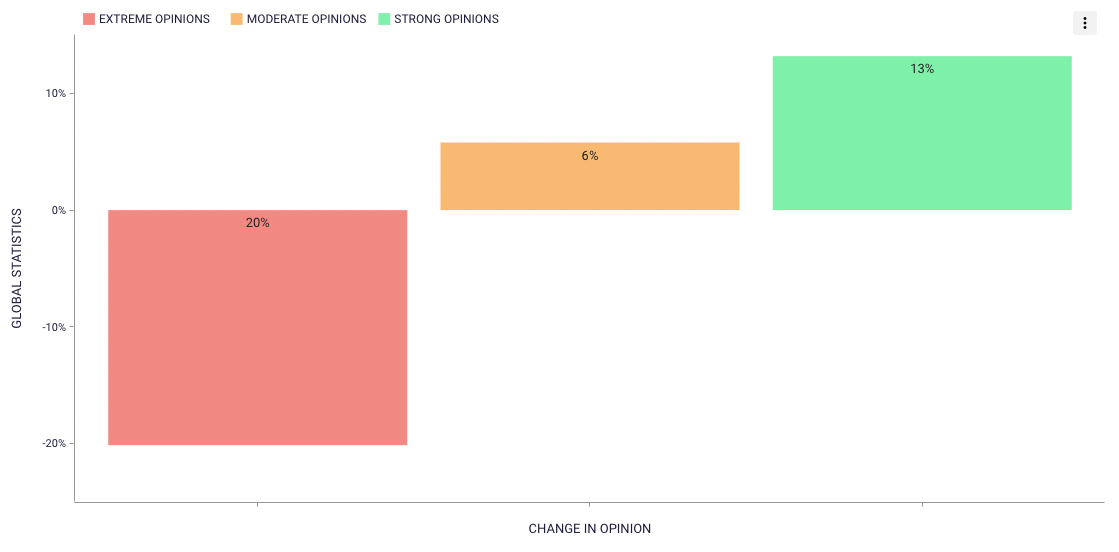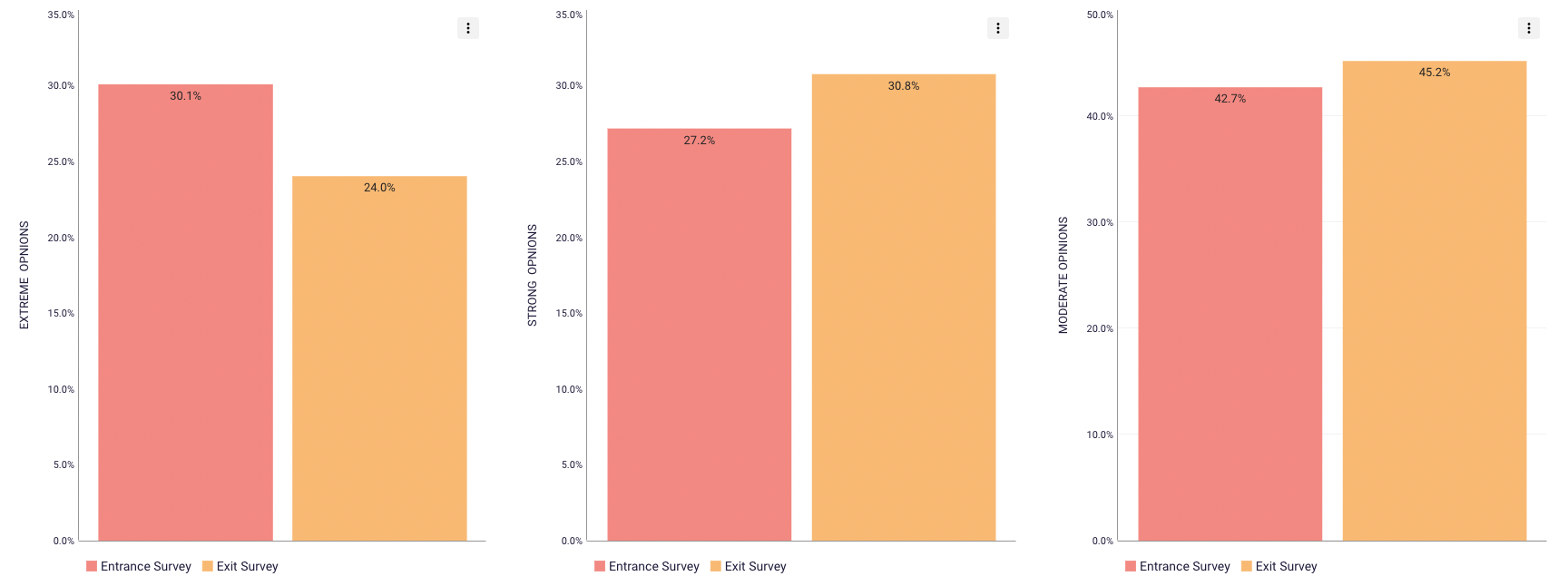2022 Ethical Dilemmas - Survey Analysis
The goal of this survey is to examine changes in the ‘level of opinion’ expressed by participants before and after completing a college philosophy of ethics course. Meaning, did participants develop stronger views or were their opinions tempered? Did participants move from not having opinions (ambivalence) or towards having more robust opinions on topics? A particular metric of interest is extreme opinions. The question being; did the ethics course cause students to move towards or away from expressing extreme viewpoints?
IMPORTANT: This survey included an extremely small sample size of 13 participants completing both the Entrance and the Exit surveys. As such the data and analysis within this project should not be viewed as conclusive. The survey is designed as a starting point to guide further research.
Background - Why Might This Data Be Valuable?
Contemporary local, national, and global threats of extremism are becoming widely feared but very little is understood about the causal mechanisms of extremism and or extreme political partisanship. In addition, there is very limited data that can point towards effective solutions for reducing existing extremism or insulating people from becoming extremists. It has become clear that online social networks are a focal point for extremist indoctrination and extremist movements, but there are many moving parts involved in driving a person from a moderate or even strong set of perspectives into a state of extreme ideology.
One way to potentially prevent or reduce extremism is through education. The United Nations Educational, Scientific and Cultural Organization (UNESCO) has a concise brief entitled “Preventing Violent Extremism through Education: Effective Activities and Impact” which outlines some effective educational techniques as well as expressing the unfortunate lack of empirical data available on effective prevention of extremist indoctrination. Link: (UNESCO Preventing Violent Extremism Through Education). What is not covered in the the UNESCO brief, or many briefs on preventing extremism, is whether existing educational programs are already potentially reducing (or increasing) extremism. It would be useful to understand if there is a kind of prophylactic effect (or conversely, an unwanted amplifying effect) created through certain paths of education. For instance does a Philosophy of Ethics class reduce tendencies towards extreme partisan views. And, might a Philosophy of Ethics class paired with a Debate class have a cumulative insulatory value? This survey is designed to highlight a potential starting point into further research. If they prove to be effective in preventing extremism, there are many advantages to leveraging existing (or augmented) educational curricula rather than, or in addition to, introducing novel educational practices.
Survey Setup and Understanding the Data
Survey participants were asked to give their opinion on the following 8 topics in both an Entrance survey at the start of the course and again in an Exit survey at the end of the course:
Conservative vs. Liberal (How Participants Choose to Identify)
Capitalism vs. Socialism
Abortion
Labor Unions
Joe Biden’s Student Debt Relief
Gun Control
The Nature of Politicians
The Marvel Character Thanos
For each topic the participants were first asked if they self identified as being for, against, or unfamiliar with the given topic. Participants were then asked to express their level of opinion regarding the topic on a scale from 0 to 5. For instance, a participant might first identify themselves as Pro Labor Union and then follow by choosing an opinion level of 4. Alternatively, a participant may express that they are unfamiliar with a topic and or that they do not identify as for or against the topic, but still choose their level of opinion for or against OR abstain from selecting a level of opinion. The survey was administered to participants at two instances in order to compare any changes in opinions over the time span of one college semester.
Extreme - Strong - Moderate
Participant opinions are expressed on a scale from 0 to 5 and then parsed into one of three categories; Extreme, Strong or Moderate. The numerical breakdown of opinions into categories is as follows:
Extreme - 5
Strong - 3, 4
Moderate - 0, 1, 2
Note: Moderate is the largest pool as it includes three available responses (0,1 or 2) while Extreme is the smallest pool and only includes level 5 opinions. Because of this un equal parsing, it can be expected that most opinions will register as Moderate and fewer opinions will register as Extreme. For this reason it is valuable to compare Entrance Extreme opinions to Exit Extreme opinions, but not necessarily valuable to compare the total number of Extreme opinions to the total number of Strong or Moderate.
Results
Did opinions overall become more or less extreme? The first chart below presents the increase or decrease in types (Extreme, Moderate, Strong) of opinions across all questions (globally) between the Entrance and Exit survey. For example, if the total number of 5's (Extreme opinions) selected increased from 100 in the Entrance Survey to 109 in the Exit Survey, the below chart would show a 9% increase in Extreme Opinions. As can be seen below, the results from the survey show that instances of Extreme Opinions decreased by 20% for participants when taking the Exit survey.
Instances of Extreme Opinions decreased by 20% - Instances of Moderate Opinions Increased 6% - Instances of Strong Opinions increased by 13%
The total number of extreme opinions selected by participants decreased from 31 to 25. Furthermore, this decrease was spread across the participant group, meaning there was not a single or small number of participant(s) who had dramatic shifts, but rather small shifts in aggregate accounted for the total decrease in Extreme Opinions given. Also, not all participants had a reduction in their Extreme Opinions… although 5 participants selected fewer Extreme Opinions, 3 participants selected a higher number of Extreme Opinions.
The charts below show side by side caparisons of the percentage of each type of choice (Extreme, Strong, Moderate) given in the Entrance Survey and the Exit Survey.
The left chart depicts Extreme Opinions (Entrance Survey next to Exit Survey), while the middle chart shows Strong Opinions and the right chart shows Moderate Opinions.
Each of the 8 Charts in the carousel below show a breakdown of the Change in opinions by topic, rather than globally across all questions as the charts above express.
From the 8 chart carousel above, I think there are 2 very distinct patterns to mention. First, Extreme Opinions decreased or stayed the same in every single category. In addition, Strong Opinions increased in every single topic accept opinions about Labour Unions. Delving into the data on labour unions, we see that there was an overall decrease of opinions given from the Entrance to Exit Surveys. In the Entrance Survey 12 of the 13 participants gave an opinion on labour unions, however only 9 of 13 participants gave an opinion on the topic in the Exit survey. Furthermore, it was the only topic in which participants abstained on the Exit more than on the Entrance survey. Meaning, in every other topic the number of opinions selected was either the same or increased from the Entrance to the Exit Survey.
Conviction in Beliefs VS. Still Forming Opinions
The final question on the survey asked participants to identify themselves as either “I feel conviction in most of my beliefs” OR “I’m still forming these opinions”. This question was distinct from the other questions in the survey as it was not about group affiliation or an opinion on a contemporary issue, but rather a self assessment. I believe some of the most interesting insights can be seen in the results from this single question relative to the rest of the survey. First, on the binary question… “Have you changed your ethical stance on anything, such as abortion, gun laws, voting rights, etc. in the past two years?” The Yes or No answers moved a noticeable amount as shown in the first 2 charts below. Participants moved away from identifying as having conviction and towards having changing viewpoints.
Moreover this shift in conviction is quite profound when we look at the numbers participants chose to apply to their personal “Level of Conviction”…
Expressions leaning towards having changing opinions (choices marked 0 - 4) dramatically increased from 4 up to 10.
Expressions leaning towards having conviction in opinions (choices marked 6 - 10) dramatically decreased from 8 down to 3.
Conclusions & Likely Weaknesses in Data
Weaknesses: As previously mentioned, this survey included a very small sample size and any analysis must first admit that the above data cannot be deemed conclusive due to such a small data set. I hope to spend some more time looking at data comparisons between participants who completed both entrance and exit survey vs. participants who completed only the entrance survey. I imagine an amount of self sorting could have taken place where only certain types of persons completed both surveys. There is also no control data… it would have been valuable to have given this survey to participants not enrolled in the ethics class for the sake of having a baseline comparison. There also could have been many outside factors, including world events, political events, etc. that influenced participants during the timespan of the study.
Thoughts: For the sake of theorizing, I would like for a moment to assume/imagine that the data above is representative of actual results/efficacy from this, and maybe other, ethics classes. From this perspective I think the results are very much in line with my hopes and expectations. The results are so ‘good’ that I have to fear my own confirmation bias in data interpretation. The survey data strongly suggests that participants (in aggregate) had a marked decrease in extreme views, while at the same time maintained strong opinions on subjects. On top of this healthy result, it seems clear that participants were willing to express that they have a much stronger inclination towards changing their viewpoints. I would interpret this as a movement towards open-mindedness, or potentially the ability to accept more ideas without rejecting concepts based on preconceived notions or personal ideology.
As for causal mechanisms, my hunch is that group discussion & debate are the main drivers of these potential positive outcomes. When faced with the task of expressing our ideas/opinions to others (persons with conflicting opinions), we are forced to think more deeply on a topic… we are more likely to truly and honestly reflect on all the facets that may be present. This is a very different process from the common preaching-to-the-choir conversations that many people are engaged in outside of an academic environment. I’m not quick to assume that the actual course content (the learning material/subject of the ethics course itself) is the main determinate of results.Hopes: I would love to see further exploration and experimentation devoted to analyzing the effects of existing educational models as they relate to extremism and overall social stability. I believe promotion of certain types of classes and studies could have a much needed positive effect on our democratic social structure by instigating open-mindedness while insulating people from falling victim to extremist ideologies. Importantly, I think this can be done without the risk of amplifying specific liberal, conservative, or party leaning views and or indoctrination.












